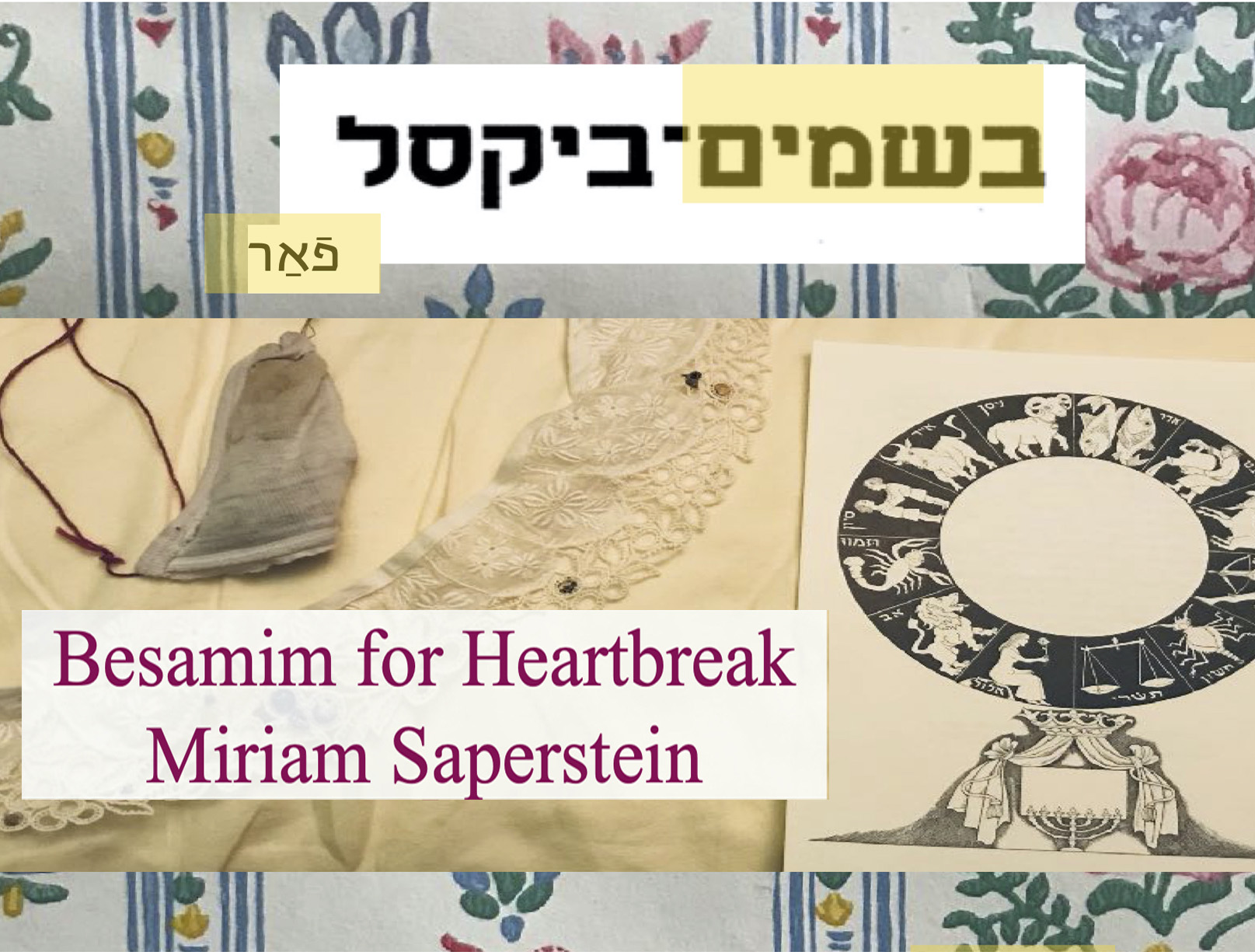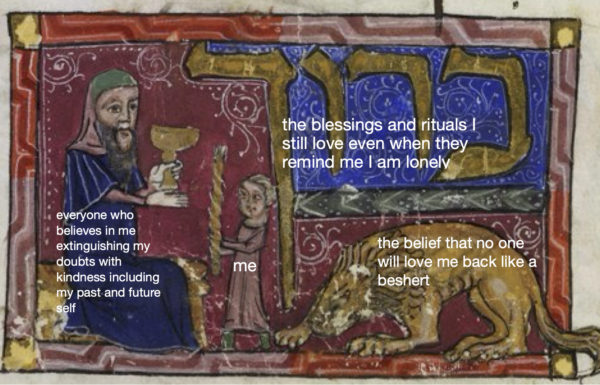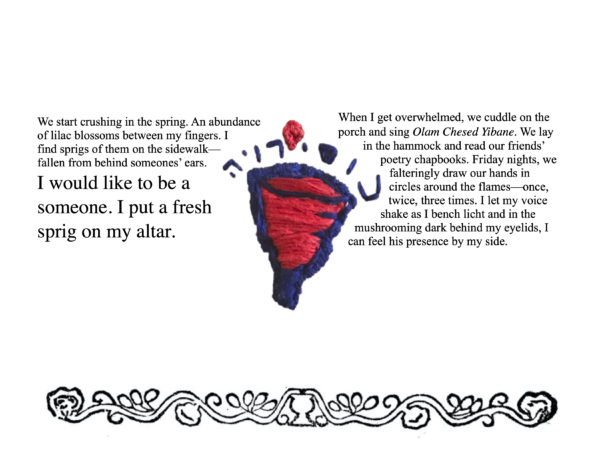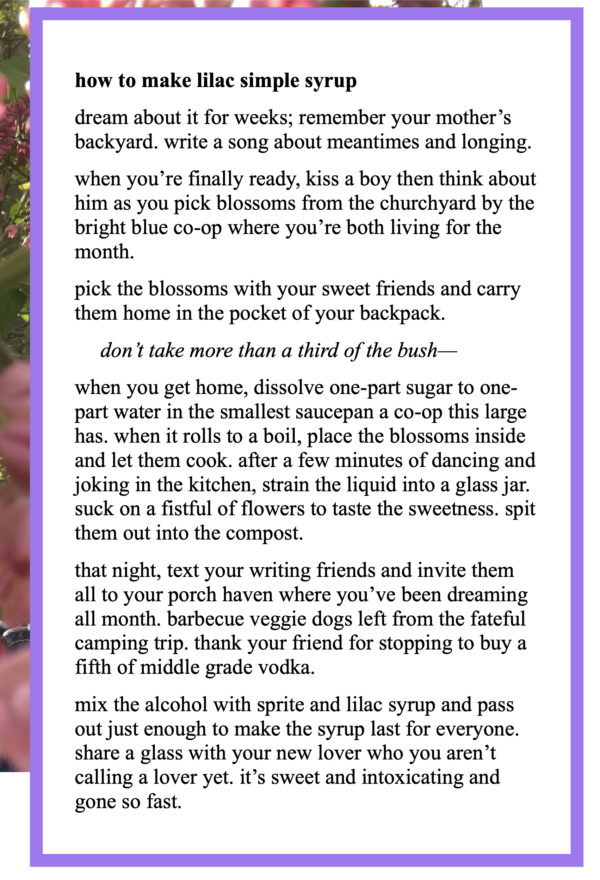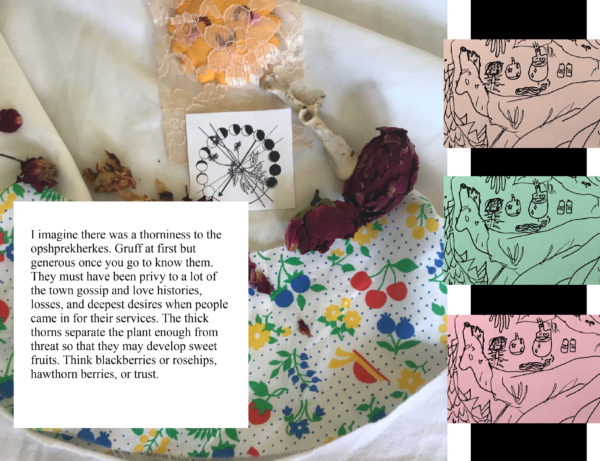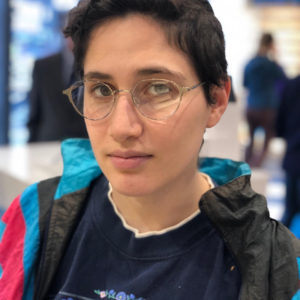What happens when two people in an interwoven community break up?
To answer that question, New Voices Fellow Miriam Saperstein braids together archival research, poetry, ritual practice, collage, embroidery, illustration and personal narrative, in a new zine centered around Besamim, the Jewish practice of smelling spices during the end of Shabbat ritual, Havdalah. This zine explores monogamy/polyamory, trans Jewish partnerships, and the passing down of traditions/communications/expectations. A confessional glimpse into ritual and relationships, Besamim for Heartbreak mourns, swirls, and reenacts boundaries, just like the Havdalah ritual itself.
Just released this week, “Besamim for Heartbreak” is available online here for download or purchase. New Voices Magazine sat down to speak with New Voices / Jewish Currents Writing Fellow Miriam Saperstein to discuss “Besamim for Heartbreak” and the process behind its creation.
New Voices: Looking back on the months of production, what was the most meaningful part of writing “Besamim for Heartbreak”?
Miriam Saperstein: Finishing the zine felt like an exorcism— the last day, I sat on my porch for 12 hours straight, just reveling in combining all the cool things I had learned in final touches, trying to get it done before sundown and the start of Shabbat. Pulling all of the research and ideas together in the final format felt so good, like physically, spiritually amazing. I went into Shabbat that week feeling exuberant. Right after I finished, I called up a friend, and it was so nice to share my excitement with someone. She also reminded me to eat, which was very important.
New Voices: What inspired you to write this zine?
Miriam Saperstein: I had a sense it was time ready to revisit an essay I wrote last fall while dating and then breaking up with my partner at the time. I wanted to look at the essay with more nuance and clarity since time had passed, and reflect on how I was feeling now.
I wrote the original text for a class on braided essays. They’re a writing form where you weave together separate threads into one whole, combining different styles or narratives. It’s very fluid and mirrors the way I like to think about different concepts—what are all the different things that influence each other?
The class gave me a container where I had to process my choices and options. When I started out, I thought I needed to write about the evil eye and Jewish exorcists as a way to get over my jealousy. Then I realized that maybe I needed some divination support in exploring what possibilities were open to me. As I reflected on the divination practices, it became clear that I needed to break up with my partner, and that in turn led me to the question of “what rituals do I have to support me through this?” I’d been playing around with besamim as amulets for a few years, and that felt powerful. I ended up braiding together those three explorations into a very raw piece that later became the main text of this zine.
New Voices: This zine is full of art, archival materials, and curated visuals. How did you go about the process of making and finding images for this zine?
Miriam Saperstein: I love exploring a concept through ritual and art at the same time. The boundaries between what is shared/private, ritual/performance, are always more watercolor for me than architecture blueprint. That makes Havdalah, a boundary/separation ritual, a great holder for these explorations. Throughout making this zine, I went in a lot of different directions with my research, but they all started out with Havdalah, and eventually led back to a deeper interpretation of this ritual.
I went deep into the digital archives, down the rabbit hole, one might say, looking for images of hare hunting. These hare-hunting images were common in at-home prayer books, sometimes called bentschers, due to a pun (that one of the creators of this bentscher taught me about): the acronym for the steps of havdalah sounds like the German words for “hare hunting.” And there’s a play on the ideas of Jews being the hare now and the hunters when Moshiach (the messiah) comes. This raised questions from me. I don’t want to be the hare hunter in the end, I just want to live in a cute cottage with bunnies that don’t eat my garden.
The bentscher research led me to other types of books, like medieval Minhagim (customs) books which detailed how to practice different rituals. It was fun and challenging trying to track down the original documents from a mention in an article, especially when similar books were printed in various years and locations. I also found haggadot very helpful, as they have images and include Havdalah in the event of Passover starting at the end of Shabbat.
The highlighted text on the title page references the research process, which for me is a lot of searching keywords in different databases, something that becomes tricky with transliteration and terms that are different in different languages. I love figuring out new search terms, like a spelling or pronunciation I haven’t seen before. And as my Yiddish improves, I’m able to access more primary sources.
One really exciting development was learning the phrase “agmes-nefesh,” or soul-aggravation. According to Marcus Jastrow’s Talmud dictionary, agmes comes from a root which means to be bent or weighed down (by grief). Nefesh means soul. The Yiddish usage of “agmes-nefesh” suggests distress, and can refer to heartache. It can be serious or more tongue-in-cheek. The phrase felt fitting because the zine talks a lot about Shabbos souls, and it’s not really a broken heart (hartz), but more an achey soul (nefesh). Also, I’m achey— not broken. There’s that feeling when old wounds are irritated. It relates to the sense of annoyance, of not again, not like the original loss, but just that old stuff is coming up for me.
New Voices: What wasn’t included in this zine?
Miriam Saperstein: There was enough material for a whole new zine just from doing the image research. For example, I came across this poem by Miriam Ulinover called Havdole Vayn. In the poem, a grandmother cautions her granddaughter not to drink the wine at Havdalah because it will make her grow a beard. I want to rewrite that as a midrash of an elder teaching a young trans person how to use Havdalah magic to cross gender boundaries in their expression.
For the zine, I wanted to focus on sources beyond the Talmud (which centers men), expanding what is thought of as Torah. For example, I used forms like recipe-writing to bring into question what kind of sources are seen as central to a ritual. When I set out to find primary sources about what are traditionally viewed as women’s traditions, most of what I had access to were practices recorded by men. And while there are historic examples of Jews who experienced their own version of transness or nonbinary gender, those perspectives were left out of the sources that felt directly tied to the theme of Havdalah. So one glaring omission is sources that let ancestors of many genders speak in their own words. For modern sources, there’s been a lot more written. I wasn’t able to include it in the end, but the “Twilight People Prayer” has been greatly influential on my experience of Havdalah.
Despite its omissions, the Talmud has some really great stuff. One thing I learned while searching keywords on Sefaria, a Jewish texts database, was that Eliyahu, bringer of moshiach, won’t come on Friday night or the evening when a holiday starts. That’s because everyone would come out to greet them and not have time to get ready for Shabbos. That’s how magical Shabbos is!
New Voices: This zine is quite personal and mentions real experiences—how did you make decisions around who and what to disclose/include in the zine? What was that process like?
Miriam Saperstein: The braided essay structure allows for hiddenness—there are parts of the thread that get tucked behind another thread, so you don’t have to share the whole story but it can still be a complete braid. I worry about the consequences of sharing something so vulnerable. It’s not the most complete, up-to-date version of how I feel, and what if I change my mind? And what if people make assumptions about me because they don’t know where I’m coming from? I’m just very anxious about what people think of me and I’m not proud of that. But like my friend said, it’s really practicing the “thorniness” I talk about in the zine— the reader doesn’t need to know my entire relationship history, my trauma, my deepest hopes, but they are there, in the ether around this text.
New Voices: There’s a lot of heavy and emotional content throughout this zine. What was the most difficult part of writing “Besamim for Heartbreak”?
Miriam Saperstein: There’s real people referenced here and my relationships to them have changed as I was writing the essay, and also between the essay and zine processes. I feel sad about that. But writing the zine itself felt really empowering. I don’t have to be embarrassed about how I’ve historically stayed in relationships because I was afraid no one would love me the way I wanted to be loved. Revisiting the essay a half-year later helped me come to terms with how this is, in part, a story about how past trauma influenced later relationships. Revision reinforced how I get to make choices about what happens next.
New Voices: Who do you hope this zine will reach?
Miriam Saperstein: I hope it reaches people who love to geek out about the kinds of things I like, and that people find an image that sparks curiosity and look up where it came from, giving them new material to engage with for their own art. Or maybe someone will find a question that supports them in reflecting on what their own boundaries are. Mostly, I hope some part of it is validating to people who are wondering if their desires are too much, because it is no good staying in any kind of relationship that makes you doubt whether you are too much.
New Voices: Looking to the future, where do you want “Besamim for Heartbreak” to go from here?
Miriam Saperstein: I hope other people respond to this zine with their own art, and share that art with me because that is super cool. This zine responds to the ideas and work of a range of artists, legal theorists, writers, archivists, and I’d love for people to continue that conversation. ⋄
“Besamim for Heartbreak” is available online here for download or purchase. Miriam Saperstein is a white Ashkenazi Jew from metro Detroit, and New Voices/Jewish Currents Fellow for 2020. They currently reside in Ann Arbor, occupied Anishinaabe territory, where they study Judaic Studies and Creative Writing at the University of Michigan. Their art has recently appeared in PROTOCOLS as well as ctrl + v journal. For more of their artistic explorations, you can find them at (@bitter_water_babe) on instagram and on soundcloud.
